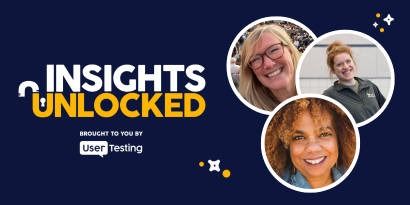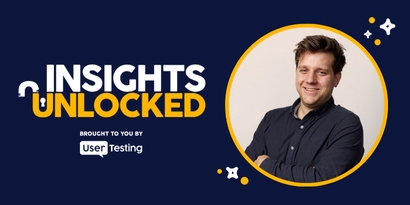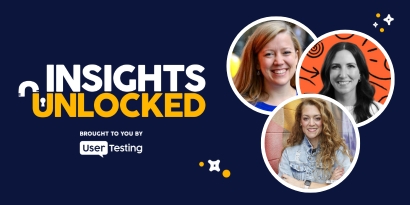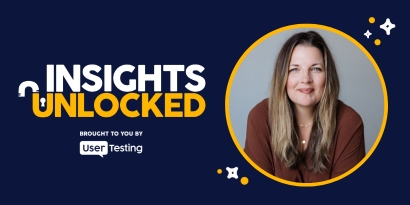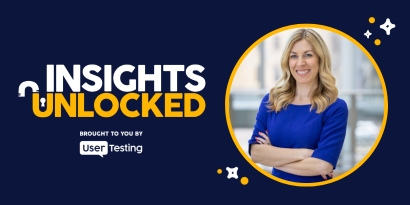
Episode 157 | February 10, 2025
AI meets human insight: UX research at Consumer Reports
How AI and human insight shape UX at Consumer Reports. Learn how 90 years of data powers AI, with human-in-the-loop research across product, advocacy, and more!
How AI is Shaping UX Research at Consumer Reports
Artificial intelligence is transforming industries, but when it comes to AI in UX research, who should take the lead—AI or human researchers? According to Melissa Garber, Senior User Experience Researcher at Consumer Reports, research should be the driver, shaping AI to enhance consumer experiences rather than replace human expertise.
In a recent episode of Insights Unlocked, Garber shared how Consumer Reports is integrating AI into UX research while ensuring human-in-the-loop AI remains central to maintaining trust, accuracy, and user satisfaction. Her conversation with Brent Leary was recorded at The Human Insights Summit in October.
AI in UX Research: a tool, not a replacement
As AI-powered tools become more sophisticated, some worry they might replace traditional research roles. However, Garber sees AI as an augmentation rather than a substitution for human insight.
"AI doesn’t reason—it recognizes patterns," Garber explained. "It can pull sentiment, but it doesn’t truly understand emotion or context. That’s why human insight is still crucial."

At Consumer Reports, Garber and her team have been working on a conversational AI agent that leverages retrieval-augmented generation (RAG) to provide consumers with relevant, data-driven insights. This AI model pulls from nearly 90 years of Consumer Reports data to assist consumers in making informed decisions.
However, one of the biggest challenges with AI in UX research is ensuring that AI delivers the right information in a way that users can understand and act upon.
Anticipating consumer needs with AI
One of the fundamental challenges of AI-powered UX tools is that users don’t always know what to ask. Traditional search engines rely on users to input the right query, but AI-driven systems must anticipate what users need before they even realize it.
"A lot of people struggle with search queries," Garber noted. "They don’t always know the right terms to use. That’s why anticipating user intent is crucial—so AI can provide helpful suggestions and guide them to the right information."
This means designing AI-powered tools that:
✅ Offer smart suggestions based on user behavior
✅ Provide predictive recommendations using historical data
✅ Adapt to natural language patterns for better usability
By structuring AI-powered responses in a user-friendly, actionable way, researchers can help ensure technology truly benefits consumers rather than overwhelming them.
"Users don’t always know what to ask. Predicting their intent is key to making AI-powered experiences more useful." — Melissa Garber
The role of human-in-the-loop with AI
AI still hallucinates, even when it’s using Consumer Report's own data, Melissa said.
"Even when you're using your own data, it still hallucinates," she said. "That's why we have something at CR that we call human in the loop to make sure we are maintaining our brand integrity and the trust that we've built over almost 90 years."
This hybrid model of AI and human oversight helps:
🔹 Reduce misinformation
🔹 Ensure brand voice and trust remain intact
🔹 Improve AI’s long-term learning and refinement
Balancing innovation with consumer trust
One of the biggest challenges in adopting AI in UX research is maintaining consumer trust and data privacy. At Consumer Reports, protecting consumer data is a top priority.
"We have an enterprise OpenAI account, which means when I use ChatGPT, it's not contributing to external training data," Garber explained. "We’re very particular about where data is stored and how it’s used."
By taking a privacy-first approach, Consumer Reports ensures that AI tools:
✔ Keep consumer data secure
✔ Maintain ethical AI practices
✔ Align with Consumer Reports' mission of advocacy and transparency
This is especially critical in an era where AI-driven personalization is often met with skepticism. By demonstrating transparency and ethical data use, brands can foster trust and engagement with their audiences.
The future of AI in UX research
As AI continues to evolve, what’s next for AI-powered UX research? Garber envisions a future where AI acts as a support system rather than a standalone decision-maker.
"At the end of the day, AI should help people be the superheroes of their own lives," she said.
This means AI will:
🛠 Streamline research processes while keeping human expertise at the core
📊 Provide predictive insights without replacing real-world validation
🔍 Enhance user experiences through personalization and smarter interfaces
However, the key to success lies in balance—leveraging AI for efficiency while keeping human oversight for quality, ethics, and trust.
AI is reshaping UX research, but as Melissa Garber emphasizes, it’s the research that should shape AI, not the other way around.
By keeping human-in-the-loop AI, prioritizing consumer trust, and focusing on user needs rather than just AI capabilities, companies can ensure that AI-powered research enhances rather than replaces human-driven insights.
As the landscape continues to evolve, one thing remains clear:
"AI should empower consumers, not make decisions for them." — Melissa Garber
Episode links:
- Exploring AI in experience research: This podcast episode delves into the evolving role of AI in UX research, discussing how AI can amplify human capabilities.
- UserTesting's Vision for Artificial Intelligence: Learn about UserTesting's perspective on applying AI and machine learning throughout the research lifecycle to re-envision experience research.
- How UX research for machine learning is different from other UX research: This podcast episode discusses the unique aspects of conducting UX research in the context of machine learning and AI.
- Putting AI to work in experience research: Discover how AI can be utilized in UX research and design to enhance workflows and collaboration between teams.
- Consumer Reports: The organization where Melissa Garber works, known for its independent product testing and consumer advocacy.
- RAG Framework (Retrieval-Augmented Generation): Mentioned as the AI model used at Consumer Reports to pull from nearly 90 years of research.
- Brent Leary on LinkedIn: The host of the interview, a recognized analyst and industry expert.
- Melissa Garber on LinkedIn

